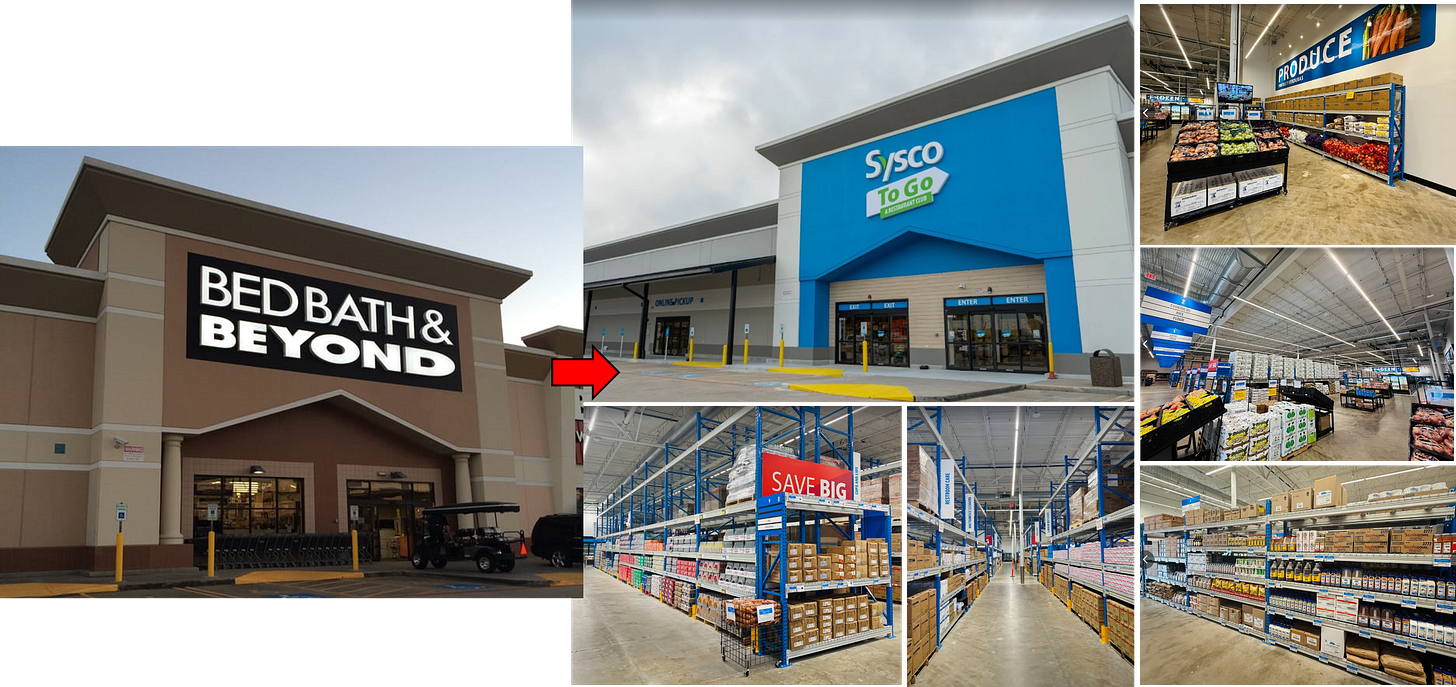Sysco, US Foods and Gordon Food Service Are Among The Largest Food Service Distributors In The U.S.; They Are Also Opening New Retail Stores Via The Adaptive Reuse of Big Box Real Estate
The first Sysco To Go store opened last week in a former Bed Bath and Beyond; US Foods and Gordon Food Service each operate over 100 retail stores including many repurposed Big Box spaces
A Sysco To Go store opened last week in Houston.
The ~48,000 square foot building is the first retail pilot store for Sysco SYY 0.00%↑, the largest food distributor in the U.S.
Sysco To Go is targeted primarily to small and independent restaurant operators that do not order enough products to justify a Sysco truck delivery.
Or who simply prefer to buy smaller pack sizes at a lower cost than if the items were shipped directly to them.
The Sysco To Go store resembles a “mini” Costco with a spartan warehouse-like interior, wide aisles and bulk food and restaurant supplies stacked on pallet racks.
It also includes refrigerators with meat, seafood, dairy and eggs — as well as a large walk-in-cooler.
Unlike Costco, though, Sysco To Go is open to the public and does not require a membership.
One other interesting thing about the new Sysco To Go?
It is located in a repurposed former Bed Bath & Beyond store.
While the retail — or “mini warehouse club” — concept may be a first for Sysco, its competitors like US Foods USFD 0.00%↑ and Gordon Food Service have long operated retail stores that are open to the public.
US Foods operates over 95 Chef’Store cash and carry retail sites in 14 states, including 4 stores that were opened just last year.
US Foods Chef’Stores have a warehouse club shopping format and are similar in size to Sysco To Go with a wide assortment of meat, produce, dairy, beverages, restaurant equipment and supplies in case and individual quantities.
Chef’Stores are open to all with no membership required.
And most were developed via the adaptive reuse of former grocery and apparel stores.
Including buildings previously occupied by Citi Trends, Lidl and Fallas Discount Stores, among others.
Gordon Food Service is one of the largest family owned U.S. food distributors.
It is also one of the oldest — having been founded in 1897.
Gordon also has been in the retail business longer than many distributors; it operates more than 180 stores and opened its first retail outlet back in 1979.
Until recently, the majority of Gordon Food Service stores were ~15,000 square feet, or slightly larger than a typical corner drugstore.
Most stores had been internally developed by the Company and built new from the ground up.
However, many recently opened Gordon Food Service stores are much larger — 50,000 square feet or more.
And, more often than not, newly opened stores have been developed via adaptive reuse or the backfill of vacant retail space.
In fact when Gordon Food Service entered the Houston market in 2023, it did so with six stores, each that was roughly twice the size of its original prototype.
All six stores were backfills of 2nd generation space that had been vacated by Big Box retailers.
Including several that were near to its competitor Sysco’s headquarters in the Houston area.
Whether it was to counteract the entry of Gordon Food Service on its home turf or simply experiment with a new concept close to its headquarters, Sysco chose Houston as the market in which to launch the Sysco To Go concept.
But Sysco is not stopping with a single store.
The Company is has second Sysco To Go location in development that is also in Houston.
Like the first Sysco To Go this new store will also be a repurpose of 2nd generation Big Box retail space:
A ~45,000 square foot former Toys-R-Us-turned-Sprouts grocery store near NRG Stadium that is expected to open this Summer.









This is the kind of smart repositioning that makes you wonder: why aren’t more landlords pursuing adaptive reuse before vacancies drag down NOI and trigger valuation doom loops?
Sysco, US Foods, and Gordon Food Service are quietly building a playbook that answers the Extend & Pretend trap,not by slashing rents, but by transforming underutilized big-box retail into productive, logistics-friendly, cash-carry assets that serve real demand.
What if cities partnered with these types of high-volume but non-credit tenants and smoothed permitting for retrofit conversions? We’re not short on square footage,we’re short on imagination and flexibility in how we treat value.